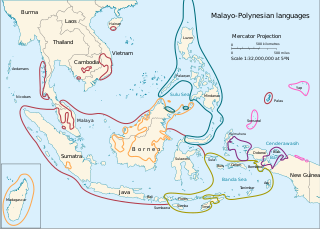Related Research Articles

Honolulu is the capital and largest city of the U.S. state of Hawaii, which is located in the Pacific Ocean. It is an unincorporated county seat of the consolidated City and County of Honolulu, situated along the southeast coast of the island of Oʻahu, and is the westernmost and southernmost major U.S. city. Honolulu is Hawaii's main gateway to the world. It is also a major hub for international business, finance, hospitality, and military defense in both the state and Oceania. The city is characterized by a mix of various Asian, Western, and Pacific cultures, as reflected in its diverse demography, cuisine, and traditions.

The Malayo-Polynesian languages are a subgroup of the Austronesian languages, with approximately 385.5 million speakers. The Malayo-Polynesian languages are spoken by the Austronesian peoples outside of Taiwan, in the island nations of Southeast Asia and the Pacific Ocean, with a smaller number in continental Asia in the areas near the Malay Peninsula. Cambodia, Vietnam and the Chinese island Hainan serve as the northwest geographic outlier. Malagasy, spoken in the island of Madagascar off the eastern coast of Africa in the Indian Ocean, is the furthest western outlier. The languages spoken south-westward from central Micronesia until Easter Island are sometimes referred to as the Polynesian languages.

The University of Hawaiʻi at Mānoa is a public land-grant research university in Mānoa, a neighborhood in Honolulu, Hawaii, United States. It is the flagship campus of the University of Hawai'i system and houses the main offices of the system. Most of the campus occupies the eastern half of the mouth of Mānoa Valley, with the John A. Burns School of Medicine located adjacent to the Kakaʻako Waterfront Park.
The Murutic languages are a family of half a dozen closely related Austronesian languages, spoken in the northern inland regions of Borneo by the Murut and Tidung.

The Malayic languages are a branch of the Malayo-Polynesian subgroup of the Austronesian language family. The most prominent member is Standard Malay, which is the national language of Brunei, Singapore and Malaysia; it further serves as basis for Indonesian, the national language of Indonesia. The Malayic branch also includes the local languages spoken by ethnic Malays, further several languages spoken by various other ethnic groups of Sumatra and Borneo. The most probable candidate for the urheimat of the Malayic languages is western Borneo.
The Ibanic languages are a branch of the Malayic languages indigenous to western Borneo. They are spoken by the Ibans and related groups in East Malaysia and the Indonesian province of West Kalimantan. Other Dayak languages, called Land Dayak, which are not Ibanic, are found in the northwest corner of Kalimantan, between Ibanic and non-Ibanic Malayic languages such as Kendayan and the Malay dialects of Sarawak and Pontianak.
The Kayanic or Kayan–Murik languages are a group of Austronesian languages spoken in Borneo by the Kayan, Morek Baram, Bahau, and related peoples.
The Land Dayak languages are a group of dozen or so languages spoken by the Bidayuh Land Dayaks of Borneo.
The Melanau–Kajang languages or Central Sarawak languages are a group of languages spoken in Sarawak, Malaysia, by the Melanau, Kenyah, and related peoples.
The Punan languages or Rejang-Sajau languages are a group of mutually intelligible isolects spoken by the Punan and related peoples of Borneo.
The Barito languages are around twenty Austronesian languages of Borneo, Southern Philippines, plus Malagasy, the national language of Madagascar. They are named after the Barito River.
The Greater North Borneo languages are a proposed subgroup of the Austronesian language family. The subgroup covers languages that are spoken throughout much of Borneo, as well as parts of Sumatra, Java, and Mainland Southeast Asia. The Greater North Borneo hypothesis was first proposed by Robert Blust (2010) and further elaborated by Alexander Smith. The evidence presented for this proposal are solely lexical.
The Sabahan languages are a group of Austronesian languages centered on the Bornean province of Sabah.
The North Sarawakan languages are a group of Austronesian languages spoken in the northeastern part of the province of Sarawak, Borneo, and proposed in Blust.
The Palawanic languages are a subgroup in the Greater Central Philippine-family spoken on the island of Palawan and nearby islets.
Molbog is an Austronesian language spoken in the Philippines and Sabah, Malaysia. Majority of speakers are concentrated at the southernmost tip of the Philippine province of Palawan, specifically the municipalities of Bataraza and Balabac. Both municipalities are considered as bastions for environmental conservation in the province. The majority of Molbog speakers are Muslims.
Seru or Sru Dayak is an extinct Austronesian language of Sarawak in Borneo. Smith (2017) classifies it as a Punan language.
Segai, also known as Punan Kelai, is a Kayanic language spoken in several communities along the Kelai River, Berau Regency, East Kalimantan, Indonesia.
Keninjal is a Malayic Dayak language of Borneo. Glottolog classifies Keninjal as a Western Malayic Dayak language alongside Kendayan, but Smith (2017) includes it in the Ibanic branch of Malayic based on phonological evidence.
Rejang is an Austronesian language predominantly spoken by the Rejang people in southwestern parts of Sumatra (Bengkulu), Indonesia. There are five dialects, spread from mountainous region to the coastal region of Bengkulu, including the Musi (Musai) dialect, the Lebong dialect, the Kebanagung dialect, the Rawas (Awes) dialect, and the Pesisir dialect.
References
- ↑ Kanowit at Ethnologue (18th ed., 2015)
- ↑ "Kanowit-Tanjong". The Endangered Languages Project. 2016. Retrieved 13 January 2018.
- ↑ Smith, Alexander D. (2017). The Languages of Borneo: A Comprehensive Classification. Honolulu, HI: University of Hawaii at Manoa. p. 13.
- ↑ Smith, Alexander D. (2017). The Languages of Borneo: A Comprehensive Classification. Honolulu, HI: University of Hawaii at Manoa. pp. 98, 102, 104–109, 296, 298, 301, 303, 305.